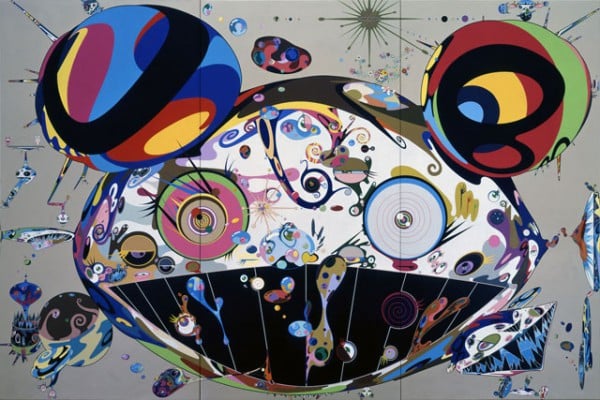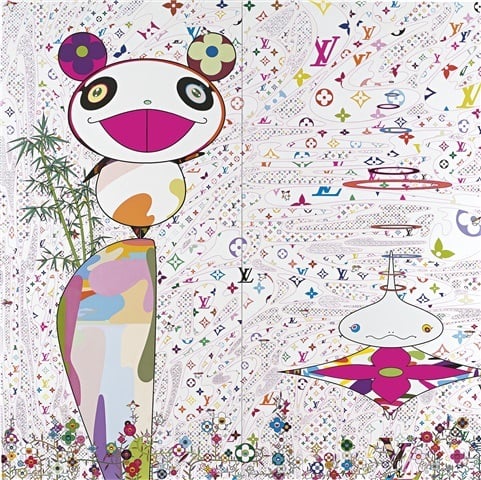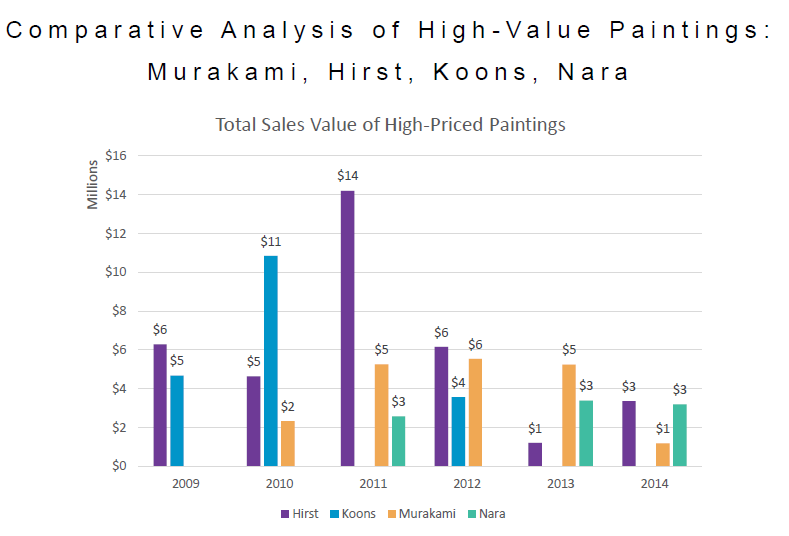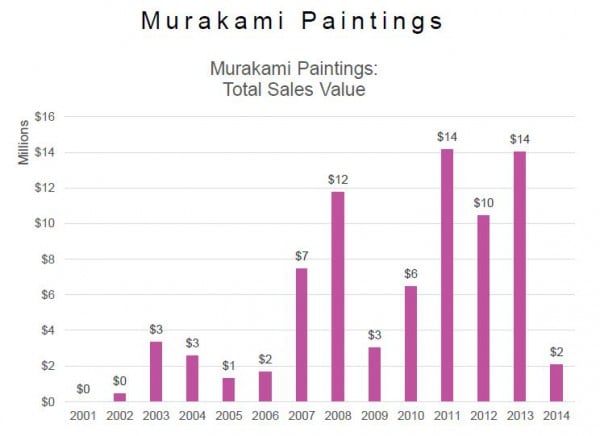Galleries
Art Market Analysis: Why Collectors Love Takashi Murakami, Part 2
Big prices lie ahead for the artist's high-value paintings.

Big prices lie ahead for the artist's high-value paintings.

Jonathan Yee &
Eileen Kinsella

Last week we looked at the thriving market for works by Japanese contemporary artist Takashi Murakami. (See “Art Market Analysis: Why Collectors Love Takashi Murakami, Part I“). Our report highlighted the notable strength of the market for his “DOB” paintings—which feature a sharp-toothed but playful comic character—and compared that to the performance of the S&P 500 (it’s been surpassing the S&P 500 since 2007). We also looked at Murakami’s growing overall popularity among collectors in Asia.
This week, with the contemporary art auctions just coming to a close (see “Epic $852.9 Million Contemporary Art Evening Sale at Christie’s is the Highest Ever” and “Rothko Reels in $45 Million at Sotheby’s 343.6 Million Contemporary Art Evening Sale“), the show of paintings and sculpture opening at Gagosian (see “Takashi Murakami Enters His Skull Period at Gagosian“), and several paintings by Murakami having come up at the day sales at Christie’s and Sotheby’s, we look at the total sale volume and performance of just the paintings, and compare them to the paintings of fellow contemporary market heavyweights Damien Hirst, Jeff Koons, and Yoshitomo Nara, another Japanese contemporary artist whose market is experiencing a rapid ascent.

Takashi Murakami’s diptych The World of Sphere (2003) sold for $2 million at Sotheby’s Hong Kong in fall 2013.
Murakami’s record for his paintings is $4.2 million, which was set by The Castle of Tin Tin (1998), a DOB painting that sold at Sotheby’s New York in November 2012. Hirst’s record is over twice that at $9.6 million for his butterfly painting Eternity (2002–2004); for Koons its $5.1 million for Loopy (1999) from his “Easyfun Ethereal” series, and for Nara it’s $2 million for Night walker (2001) featuring one of his rebellious child characters seemingly lost in a dream.
Honing our lens even further and focusing on high value paintings alone (i.e., those that sold for more than $1 million each), we look to artnet Market Watch data, which shows information about the total auction sales and average sales price for high value paintings of Hirst, Koons, Murakami, and Nara (see the chart above). Though the volume of high value paintings is clearly greater for Hirst and Koons, further analysis shows that average prices for Murakami (and Hirst) are nonetheless comparable, and rising.
In 2008, one of the highest peak years for the contemporary art market, and which was just prior to its precipitous decline, the total auction sales for Murakami’s high value paintings was $3.3 million at an average of $1.6 million per work. In contrast, the total auction sales for Hirst that year was $92.4 million with an average sales price of $1.8 million per work. Tabulating the same figures for Koons that year, the total sales were $12.2 million with a slightly higher average of $3 million per work.

Source: artnet Market Watch
While no high-value Murakami paintings are listed for 2009, the number picks up again in 2010, with one work selling for $2.3 million. In 2011, that total number rose to $5.2 million at an average of $1.3 million per work and remained about the same in the next two years totaling $5.5 million in 2012 and $5.2 million in 2013, at an average of $2.76 million and $1.7 million per work, respectively.
Meanwhile, the totals and average sale prices for Hirst’s high value paintings fluctuated far more wildly. In 2009, the total was $6.3 million with an average price of $1.6 million. In 2010 the total dropped to $4.6 million while the average price of works rose to $2.3 million. In 2011, the total jumped to $14 million though the average price dropped again to $1.3 million and in 2012, the total was back down to the vicinity of its 2009 number at $6 million with an average price of $1.5 million.

Source: artnet Market Watch
artnet Market Watch data show that the sales volume of Murakami paintings, in general (not just those that are high value), leaped to nearly $12 million in 2008 from $7 million the previous year. Amid the fallout from the global economic crisis, the sale volume of Murakami paintings dropped sharply to $3 million in 2009 (following the decline in the broader art market). However, volume has recovered well in the ensuing years, hitting over $6 million in 2010 and rebounding to $14 million in each of the years 2011 and 2013. (Final data for 2014 auction sales is not yet available.)
Although the markets for high value paintings by Hirst and Koons yield higher total sales value, the average price for Murakami’s paintings in this category has remained on par. Hirst and Koons have also not bested their 2008 highs, while Murakami and Nara’s total sales have exceeded their pre-recession numbers.
Further, artnet Market Watch data show that while Murakami is still young in terms of auction history, consistent growth can be seen in the total of his high-priced painting lots. The total sales of Murakami’s high-priced painting in 2013 were more than four times the total in 2006.
Taking a step back from the high value works for a moment, the presence of Murakami’s works in the day sales at Christie’s and Sotheby’s shows that he’s a varied artist producing works all across the price spectrum. There were two Murakami lots offered at Sotheby’s, which fell solidly within expectations. These included Mushroom (2002) an acrylic on canvas that sold for $31,250, and Kaikai (2000), and acrylic on canvas work mounted on panel that sold for $125,000. Three paintings were offered at the day sales at Christie’s, including Whoooooooooosh!, a red acrylic on linen painting, which sold for $233,000, way above its $150,000 high estimate, and Eye Love Superflat, one of his paintings with the Louis Vuitton logo, which sold within its estimate for $197,000.
While the year is not out, thus far in 2014, 14 Murakami works have come up for auction with the highest being a painting that sold in April for $1.2 million at Poly Auction in Hong Kong. A painting estimated to sell for $2 to $3 million at Sotheby’s in New York at the May contemporary art evening sale failed to find a buyer. Most of the other paintings of his that have sold have been around the $30,000 range showing that many collectors, not only the big spenders, can get a chance to love Murakami.
The graphs above reflect sales through September.
For the complete report click here.